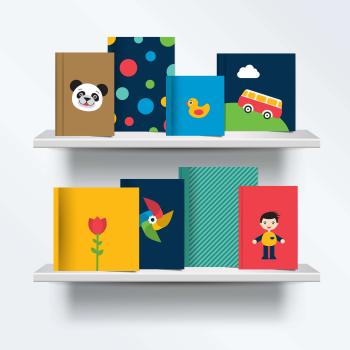Postmodern Picture Books in Middle School

- Preview |
- Standards |
- Resources & Preparation |
- Instructional Plan |
- Related Resources |
- Comments
Overview
Picture books are typically thought of as texts for young readers. This lesson uses the postmodern picture book Black and White, by David Macaulay, to engage students in a deep analysis of writer's craft. Macaulay's book presents four separate story lines that playfully interact with one another throughout the text. Students explore ways in which authors use words and illustrations to create unexpected plots and connections within a text. Students also study relationships between words and illustrations represented in the text.
Featured Resources
Story Map: Your students will use this handout to record setting, characters, and events, and to explore plot connections and author craft.
From Theory to Practice
- Multiliteracies focus on the many modes of representation and forms of text that have been made available through multimedia and technological change. Therefore, being multiliterate requires not only the mastery of communication, but also an ability to critically analyze, deconstruct, and reconstruct a range of texts and other representational forms.
- Literacy education must focus on critical engagement and understanding of text and its inherent ideologies, in all forms, as well as competency in creating such texts.
- The postmodern picture book appeals to a much wider age span, level of sophistication, and range of reading abilities.
Common Core Standards
This resource has been aligned to the Common Core State Standards for states in which they have been adopted. If a state does not appear in the drop-down, CCSS alignments are forthcoming.
State Standards
This lesson has been aligned to standards in the following states. If a state does not appear in the drop-down, standard alignments are not currently available for that state.
NCTE/IRA National Standards for the English Language Arts
- 1. Students read a wide range of print and nonprint texts to build an understanding of texts, of themselves, and of the cultures of the United States and the world; to acquire new information; to respond to the needs and demands of society and the workplace; and for personal fulfillment. Among these texts are fiction and nonfiction, classic and contemporary works.
- 2. Students read a wide range of literature from many periods in many genres to build an understanding of the many dimensions (e.g., philosophical, ethical, aesthetic) of human experience.
- 3. Students apply a wide range of strategies to comprehend, interpret, evaluate, and appreciate texts. They draw on their prior experience, their interactions with other readers and writers, their knowledge of word meaning and of other texts, their word identification strategies, and their understanding of textual features (e.g., sound-letter correspondence, sentence structure, context, graphics).
- 6. Students apply knowledge of language structure, language conventions (e.g., spelling and punctuation), media techniques, figurative language, and genre to create, critique, and discuss print and nonprint texts.
- 11. Students participate as knowledgeable, reflective, creative, and critical members of a variety of literacy communities.
Materials and Technology
Five copies of Black and White by David Macaulay (The Trumpet Club, 1990)
Printouts
Websites
Preparation
| 1. | Secure five copies of Black and White by David Macaulay |
| 2. | Review the Carol Hurst's Children's Literature Site. |
| 3. | Review the article: "It's not all black and white": Postmodern picture books and new literacies, which was originally published in the Journal of Adolescent & Adult Literacy. |
Student Objectives
Students will
- Explore unfamiliar text formats
- Interpret multiple meanings from a text
- Analyze writer's craft and writing techniques
- Discuss relationships between literacy and artistic techniques
Instruction and Activities
Initiation
Discuss the basis and format for a picture book. Tell students that they will be reading a picture book that is different than what they would expect from a traditional text.
Opening Activity
Divide students into five groups. Explain that you have a picture book that you would like them to read together in their groups. Assign four out of the five groups one story line presented in the text (ignoring the other three story lines). Assign the fifth group all four story lines presented in the text. This group should read the book as they would read a traditional picture book, page-by-page in its entirety. Although the reading is not directed, student should "discover" the unfamiliar format of the text.
 |
Group A follows the story line in the upper left corner of each page. Group B follows the story line in the upper right corner of each page. Group C follows the story line in the lower left corner of each page. Group D follows the story line in the lower right corner of each page. Group E follows all four story lines together. |
Small Groups
Provide directions for students to complete a plot summary based on the portion of the text that their group is reading. Students may use the plot summary graphic organizer. Each group will record setting, characters, and events as stipulated on the story map and to the best of their ability. Explain that some areas of the story map may be left blank depending on the story line their group is following.
Mixed Groups
When each group has finished reading and preparing a plot summary, mix the groups by having one student from each of the previous groups meet to share their plot summaries. After sharing their plot summaries, students discuss how each story line is tied together by comparing the individual plot summaries with the plot summary prepared by Group E. Students make notes as they discuss relationships between the story lines, words, and illustrations. Notes can be made on the back of the plot summary sheet for reference during the whole class discussion. The notes should indicate what students discovered about the format of the text and how the story lines interacted with one another.
 |
Whole Class
Each group reports back to the whole class what they discovered about the picture book Black and White. Discussions continue in reference to connections between the four story lines and how they interact with one another. Carol Hurst's Children's Literature Site will provide you with an overview of the topics to discuss. In addition, questions are presented that will initiate discussion of the relationship between literacy and artistic technique.
Extensions
- Explore other postmodern picture books to further develop this lesson, such as The Three Pigs by David Wiesner and Rome Antics by David Macaulay.
- Students can use Black and White as a model to write their own picture book. Divide students into groups of four. Each student in the group develops a basic story line and then the group works together to make connections among the four story lines. Depending on the level of your students, they can either develop their own original story lines or make changes to the story lines presented in the picture book Black and White. For example, the scenes on the train could be changed to occur on a subway or bus. The story with the cows could be changed to focus on a different animal. Collaborate with the art teacher so that students write the story lines in your class and develop the illustrations in the art room.
Student Assessment / Reflections
- Teacher observation of dialogue between students
- Anecdotal notes based on group and class discussions
- Students' plot summaries and recorded notes

Add new comment